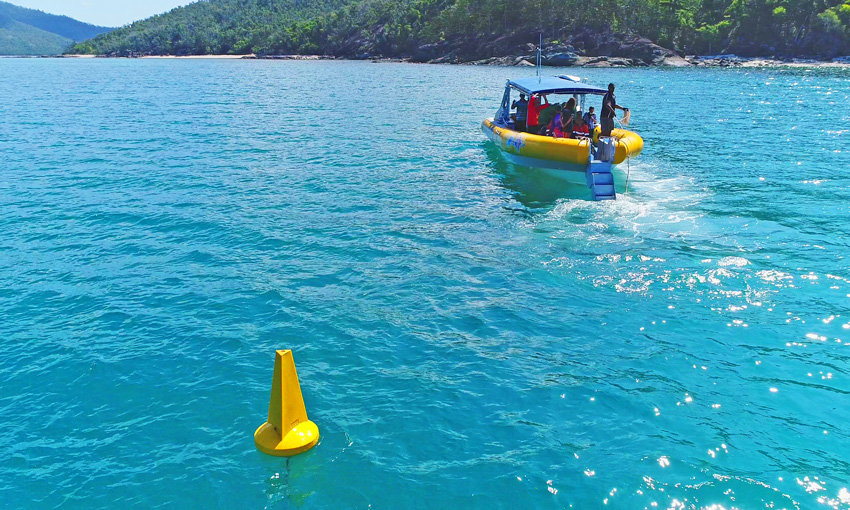A PARTNERSHIP in the Whitsundays is helping paint a clearer picture of water quality and the health of the Great Barrier Reef.
The partnership brings together the port industry, tourism operators and scientists.
The Whitsunday Blueprint for Tourism Operators – Water Quality Monitoring Program has provided training for tourism operators to collect water samples in the region.
North Queensland Bulk Ports (NQBP), which has a long-standing environmental monitoring partnership with James Cook University (JCU), has renewed its support for the blueprint, allowing the continuation of important data collection.
NQBP CEO Nicolas Fertin said the port authority – responsible for the ports of Mackay, Hay Point, Abbot Point and Weipa – recognised this valuable work to track water quality associated with reef health.
“NQBP recognises that stewardship of the North Queensland environment, and the reef, is a combined effort. This is a great collaboration helping to build knowledge and world class marine science research on water health in the Whitsundays,” Mr Fertin said.
“Collecting valuable data on the effects of natural conditions on water quality and clarity is really important and it’s great to see this program’s data sets emerging. NQBP collects almost 900,000 individual marine water quality records every year across our four ports. This ambient data informs our operations and is key to NQBP getting the balance right between environmental stewardship and supporting vital Queensland trade.”
Water loggers placed at two sites in the Whitsundays since February 2020 on the sea floor collect information on turbidity (water clarity), water temperature, water depth and amount of light from the sun extending through the water column.
“Tourism operators, trained by JCU scientists, also take water samples every four weeks, which are then analysed in a JCU water laboratory in Townsville,” Principal Research Scientist, Dr Nathan Waltham, at the Centre for Tropical Water and Aquatic Ecosystem Research (TropWATER, JCU) said.
“The program is so exciting, we are empowering the charter boat operators to be citizen scientists and play a role in the marine water monitoring.”
The blueprint’s other funding partners include the partnership between the Australian government’s Reef Trust and the Great Barrier Reef Foundation and Reef Catchments, along with support from Whitsunday Charter Boat Industry Association (WCBIA), Mackay Whitsunday Isaac Healthy Rivers to Reef Partnership and Whitsunday Bareboat Operators Association.
Whitsunday Charter Boat Industry Association Secretary Sharon Smallwood said the association’s members “took the stewardship of their patch of paradise very seriously.”
“The health of our waterways is fundamental to the experience we provide for around one million visitors per year to this section of the Great Barrier Reef Marine Park,” Ms Smallwood said.
“For many years we’ve been hearing anecdotal reports of changes in water quality around the Whitsunday islands and fringing reefs, mostly pointing to a decline. The multi-million-dollar question has always been why?
“The answer is proving to be complex and multi-faceted, requiring the input of governments, NGO’s, industries, scientists and the help of an army of volunteers, or citizen scientists. In short, successfully overcoming our challenges is about collaboration.”
Ms Smallwood said the data provided through the program was a vital part of that collaboration. “With its ports directly to the north and south of us, NQBP is an essential partner in this process,” Ms Smallwood said.
“This co-designed blueprint program is about giving us valuable knowledge to inform management decisions, which we hope will help our industry recover control of its destiny and that of the reef.
“We commend NQBP for their ongoing commitment, which demonstrates ownership of corporate and social responsibility in operating on the iconic Great Barrier Reef.
We look forward to a long partnership through the blueprint project and other opportunities and are grateful to our other partners in the project, particularly Reef Catchments, (Mackay, Whitsunday, Isaac).”
Katrina Dent, CEO of Reef Catchments said the blueprint had provided a shining example of community collaboration “in a meaningful way”.
“The Great Barrier Reef Foundation through their partnership with the Australian Government’s Reef Trust and North Queensland Bulk Ports have provided the funding to make this project possible and our tour boat operators have offered use of their vessels and time working as citizen scientists, collecting vital data in order to give us a clearer picture of water quality and subsequently reef health in the Whitsundays,” Ms Dent said.

